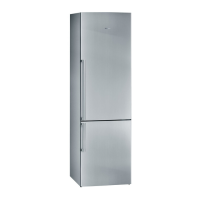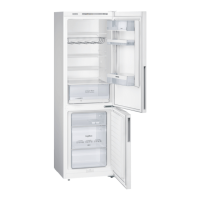Design and function
3.1 Energy label
Since 1995, the European energy label has been providing standardized information on
the energy and water consumption of home appliances.
3.1.1 Energy Label: Valid until February 28, 2021
The energy label, which has had the layout depicted below since 2012, specifies the ef-
ficiency class of the relevant appliance. It also uses language-neutral pictograms to
provide additional information on the appliance, such as its noise value and capacity as
well as energy and water consumption.
In addition to the total usable volume of all freezer and refrigerator compartments, the
label specifies the appliance’s noise value. The energy efficiency class is particularly
important for these appliances. The better the energy efficiency class, the more energy
costs can be saved - especially since these devices are in continuous operation.
Fig.1: Sample energy label for fridge and freezer appliances: Valid until February 28,
2021
1 Energy efficiency class
2 Energy consumption in kWh / year (measured under standard conditions)
3 Total volume of all freezer compartments
4 Noise emissions expressed in dB(A) re 1 PW
5 Total volume of all refrigerator compartments
3.1.2 The new Energy Label: Valid from March 1, 2021
Technological development over the past few years has resulted in a higher concentra-
tion of products that carry labels with a value of A+ or better. Consequently, the label
has not been fulfilling its original function as an aid for making purchasing decisions as
well as it formerly did. Other basic conditions like user behavior have also changed.
That’s why it’s time to adapt the existing energy label.
The procedure for determining the energy class is now more comprehensive. It takes
into account the type of appliance, its operating principle, the room temperature, and
the number and size of storage compartments. The rest of the elements on the new en-
ergy label basically remain the same. Energy consumption continues to be specified in
kWh as annual consumption (“annum”). The label also provides information on the total
volume of all refrigerator compartments and all freezer compartments, if any, and on
noise emissions and the noise emission class.
The most significant change in the new energy labels is the elimination of the energy
efficiency plus classes like, for example A+++. In the future, classification will be from A
to G. New methods will also be used for measuring energy consumption and determin-
ing the label class.
Design and function
2020-08-03_58300000002379_ara_en_p Copyright by BSH Hausgeräte GmbH Page8of73

